|
Intraretinal hyperreflective foci are thought to represent migrating RPE cells and/or microglia. They are considered markers of cellular dysfunction responsible for visual loss before late AMD development. Photo: Mohammad Rafieetary, OD. Click image to enlarge. |
Eyecare providers are well-acquainted with the visual acuity declines and fundus changes characteristic of age-related macular degeneration (AMD). Other visual function changes, however, may be as important or even more so in early identification of progression. A new study published in American Journal of Ophthalmology investigated the relationship between OCT biomarkers and quantitative contrast sensitivity function (qCSF)-measured contrast sensitivity, as well as assessing a longitudinal relationship with progression from intermediate to late-stage AMD.
The study, conducted at Massachusetts Eye and Ear, included 205 total intermediate AMD eyes of 134 patients (mean age 73; 63% female). Eyes included had a baseline diagnosis of intermediate AMD, same-day OCT and qCSF testing, visual acuity of ≥20/200 Snellen and 24+ months of follow-up. It was found that higher RPE volume in the central subfield and a greater number of intraretinal hyperreflective foci were linked to the reduced contrast sensitivity metrics at six to 12 cycles per degree. Both outer nuclear layer thinning in the inner ring and a greater number of intraretinal hyperreflective foci were associated with reduced contrast sensitivity at one and three cycles per degree.
Follow-up yielded 17% of eyes developing wet AMD and 25% progressing to geographic atrophy. Upon further analysis, outer nuclear layer thinning in the inner ring, subretinal drusenoid deposits and reduced contrast sensitivity at 1.5 cycles per degree were all associated with wet AMD development. With geographic atrophy, associations were formed with higher RPE volume in the inner ring, hyporeflective drusen cores, subretinal drusenoid deposits, higher hyperreflective foci count and reduced contrast sensitivity at one cycle per degree. Overall, these observations reflect the more general finding that there are significant structure-function relationships between OCT biomarkers and qCSF-measured contrast sensitivity with cases of intermediate AMD.
Intermediate AMD is a crucial point of the disease state, as it represents a critical stage for intervention, since advanced forms bring with it irreversible vision loss. Consequently, regulatory agencies have highlighted the need for sensitive and reliable functional endpoints which can detect significant functional changes over shorter time periods.
As the study authors explain in their writing, this is of particular importance because visual acuity assessment with high luminance typically remains unaffected until later stage AMD, and this has prompted researchers to look at many functional tests, with contrast sensitivity testing being quite promising. The qCSF test has more recently gained traction, claiming time efficiency and repeatability, as well as offering established normative values and a strong correlation with disease severity and vision-related quality of life.
With this being a viable option, the authors argue that “considering the variable inter-individual progression rates in AMD, identifying reliable structural and functional prognosticators would be highly valuable.”
They are hopeful that “advances in this domain may lead to timely and effective treatment, better patient stratification for clinical trials and ultimately more personalized care.”
| Click here for journal source. |
Bennett C, Romano F, Vingopoulos F, et al. Associations between contrast sensitivity, OCT features and progression from intermediate to late age-related macular degeneration. Am J Ophthalmol. November 24, 2024. [Epub ahead of print]. |


